Analogies
An analogy is a comparison between two things that are alike in some way. It shows how two pairs of words are related to each other. Understanding analogies is an important skill in language arts, as it helps to develop critical thinking, reasoning, and problem-solving abilities.
Types of Analogies
There are several types of analogies, including:
- Literal Analogies: These analogies are based on the literal meanings of words. For example, "hot is to cold as up is to down."
- Figurative Analogies: These analogies involve figurative language or idiomatic expressions. For example, "quiet is to mouse as loud is to elephant."
- Simple Analogies: These analogies involve straightforward comparisons between pairs of words. For example, "pen is to write as brush is to paint."
- Complex Analogies: These analogies involve more complex relationships between pairs of words. For example, "teacher is to classroom as captain is to ship."
Study Guide for Analogies
To effectively understand and solve analogies, consider the following study guide:
- Identify the Relationship: Determine the relationship between the first pair of words. Is it a synonym, antonym, part-whole, cause-effect, or other relationship?
- Establish the Connection: Once you have identified the relationship, establish a connection between the second pair of words based on the same relationship.
- Use Context Clues: Pay attention to the context of the analogy. Look for clues within the sentence to help you determine the relationship between the words.
- Practice: Practice solving different types of analogies to improve your skills. Use analogy worksheets or online resources to practice regularly.
- Review Vocabulary: Build your vocabulary to better understand the meanings of words and their relationships with each other.
By understanding the types of analogies and following the study guide, you can enhance your ability to solve analogies and improve your overall reasoning and critical thinking skills.
[Analogies] Related Worksheets and Study Guides:
.◂English Language Arts Worksheets and Study Guides Sixth Grade. Analogies
Study Guide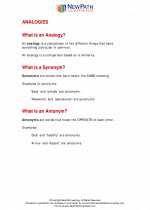 Analogies
Analogies  Activity Lesson
Activity Lesson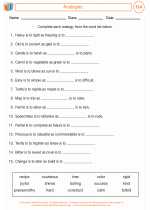 Analogies
Analogies  Worksheet/Answer key
Worksheet/Answer key Analogies
Analogies  Worksheet/Answer key
Worksheet/Answer key Analogies
Analogies  Worksheet/Answer key
Worksheet/Answer key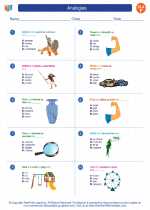 Analogies
Analogies  Worksheet/Answer key
Worksheet/Answer key Analogies
Analogies  Worksheet/Answer key
Worksheet/Answer key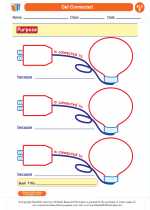 Get Connected
Get Connected  Worksheet/Answer key
Worksheet/Answer key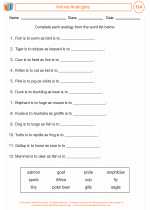 Animal Analogies
Animal Analogies 

 Activity Lesson
Activity Lesson
 Worksheet/Answer key
Worksheet/Answer key
 Worksheet/Answer key
Worksheet/Answer key
 Worksheet/Answer key
Worksheet/Answer key
 Worksheet/Answer key
Worksheet/Answer key
 Worksheet/Answer key
Worksheet/Answer key
 Worksheet/Answer key
Worksheet/Answer key

The resources above cover the following skills:
Reading for All Purposes
Word meanings are determined by how they are designed and how they are used in context. Students can:
Determine or clarify the meaning of unknown and multiple-meaning words and phrases based on grade 6 reading and content, choosing flexibly from a range of strategies. (CCSS: L.6.4)
Employ synonyms or antonyms gleaned from a passage to provide an approximate meaning of a word.